nAChR
links: Acetylcholine Receptor reference:
- [Nicotinic Acetylcholine Receptors Control Encoding and Retrieval of Associative Recognition Memory through Plasticity in the Medial Prefrontal Cortex] - encoding vs. retrieval paradigm 9-18-2021
Nicotinic Acetylcholine Receptor (nAChR) #
- Two subtypes: N1 and N2. This division is really only relevant for physiology at large and not relevant to neuroscience, since N1/NM is only found in the PNS the Neuromuscular Junction on skeletal muscle, and N2 is found only in the CNS.
-
Topology of ligand binding sites on the nicotinic acetylcoline receptor
- After the vesicle content is spilled into the synaptic cleft the time course of neurotransmitter clearance is between 0.1 and 2.0 ms reaching concentrations of 1-5 mM.
- [Selective coactivation of α7- and α4β2-nicotinic acetylcholine receptors reverses beta-amyloid–induced synaptic dysfunction]
-
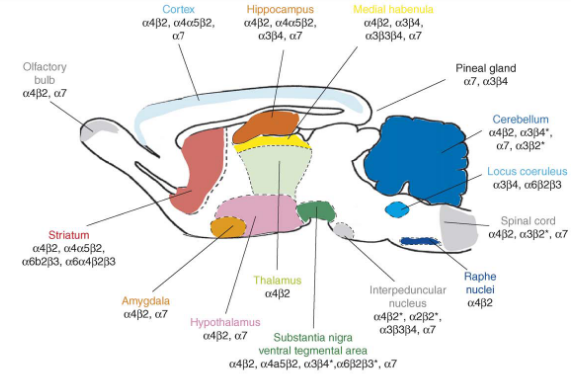
Subunits #
-
Permeabilities are significantly altered depending on subunit structure: neuronal-types, especially receptors containing α7 have higher Ca2+ permeability.
-
I α9, α10
-
II: α7 nAChR, α8 (not in mammals)
-
III1: α2, α3, α4 nAChR, α6; III2: β2 nAChR, β4 nAChR; III3: β3, α5 nAChR
-
IV (muscle-type): α1, β1, δ, γ, ε. I believe this set are all exclusively for the α$_{2 \\ }$βγδ, becoming α${_2 \\ }$βγε post-embryonic.
-
All ‘cys-loop receptors’ form a central pore out of 5 subunits to create a pentamer ion channel.
-
α7 is the only widely distributed homomer in mammals, but α9 also forms one.
-
Each subunit spans the membrane four times:
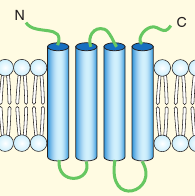
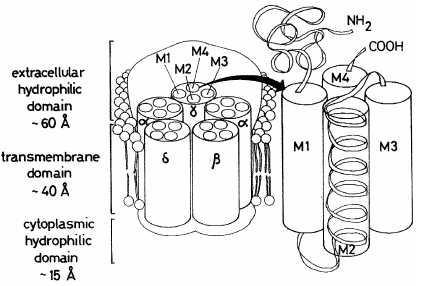
- The M2 domain is non-competitively inhibited by Substance P, Serotonin, Progesterone, Testosterone, Glucocorticoids, and Anandamide.
Heteromers #
Some of these I just kind of see. Dunno how important they are. But there’s hella subunits so imagine how many permutations of heteromers exist.
- It seems the orthosteric binding sites are only located on the counterclockwise side of each α subunit, in the extracellular domain.
-
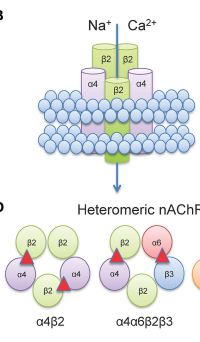
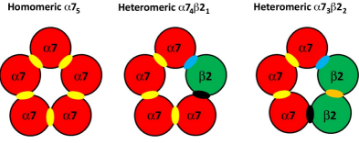
- α4β2 nAChR = 2x of one, 3x of another.
- α7β2 nAChR
- α3β4 nAChR
- α7 is low-affinity compared to α4β2.
Function #
-
While neuromuscular nAChRs mediate fast synaptic transmission, they are mostly slow in the CNS.
-
IT has been proposed that the majority of cortical/hippocampal cholinergic release sites are nonsynaptic and contribute to diffuse volume transmission, which
-
Prolonged exposure to nicotine leads to desensitization, stabilizing the ion channel to a closed state, unresponsive to agonism.
-
Presynaptic nAChR facilitates the release of other neurotransmitters while postsynaptic mediate and modulate ecitation within circuits and intracellular processes.
-
Agonists can improve mood/anxiety/aggression/cognition in depressed patients.
-
Stimulation increses dopamine concentration.
-
Inhibited by DHEA-S, T3, Pregnenolone, hydrocortisone.
- Although, DHEA-S activates the Sigma Receptor, promoting the release of ACh (and dopamine).
-
nAChR activation synergizes with AMPAR in reducing intracellular polarity, encouraging NMDAR activation.
- Interesting if true, as how does this relate to the pathology of Alzheimer’s?
Neuromoscular #
- Role of presynaptic nicotinic acetylcholine receptors in the regulation of gastrointestinal motility improves transit time